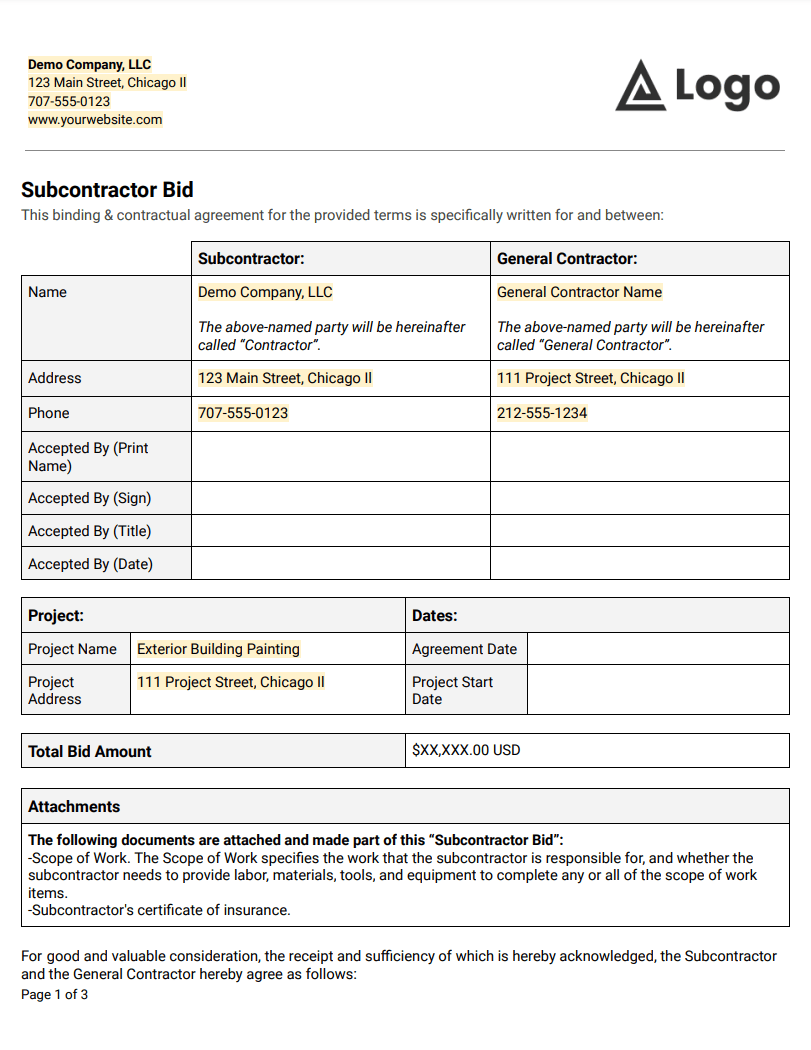How to Bid a Job as a Subcontractor (Bidding Process)
A winning bid proposal that lands you the job is accurate, well-prepared, and professionally presented.
By Nelmie Jane Pardo | Updated April 3, 2023
Table of Contents
You need to carefully consider all costs for a precise estimate and calculate just the right profit margin to keep your business thriving.
Learn how to bid a job as a subcontractor and beat competitors with our step-by-step guide. We will explain the subcontractor bid process to help you succeed in the industry.
1. Make sure you meet the qualifications.

In some cases, the contractor’s qualifications matter more than bidding the lowest dollar amount.
Review all project-related qualifications, like your company’s capacity and relevant experience. You don’t want to waste time on construction jobs you didn’t have a chance to win in the first place.
Tip: Bid selectively. The best approach is to only bid on a construction project that matches your company’s strengths, skills, and experience.
2. Review the project’s scope thoroughly.

Equipped with complete knowledge about the job, you’ll be able to estimate costs accurately and turn in a solid profit.
Review the bid documents to know the exact results your potential client wants. A site walkthrough will also help you discover problem areas that need particular attention. Additionally, you’ll know if the site conditions demand specialized equipment.
Be ready to ask for clarifications to show the general contractor you’re meticulous with your bidding process.
Don’t be afraid to walk away from a bid if you’re certain that it’s a mismatch. Ultimately, you want to win a project where you can provide impressive results without compromising profits.
Tip: Wear appropriate construction project manager attire when visiting the job site. A rugged, business-casual outfit will give you a professional vibe for the walkthrough.
3. Calculate your hard costs.

An inaccurate estimate leads to underbidding, which means losing profits.
Ensure an accurate bid by estimating the cost of all materials and tools, whether you’re preparing and excavating a site or building the structural components for walls and roofs.
Remember to avoid guesswork throughout your estimation process. Call suppliers and compare local prices for a precise estimate.
Tip: Add 10% to 15% of material costs to your estimate for additional expenses like minor mistakes and waste.
4. Estimate the labor and overhead costs.

Labor costs generally account for 20% to 40% of a construction project’s overall budget.
Calculate costs liberally to avoid underestimating a project and losing profit. You may want to consider overtime just in case your team doesn’t finish the project on schedule.
Factor in all additional costs in running your business, including worker’s compensation, payroll, paid time off, taxes, and training costs. Other overhead costs include marketing, rent, utilities, and transportation.
Add overhead costs to your total bid. For example, add $40 per day if you incur $800 each month for overhead costs and you operate 20 days a month.
If you find material and labor cost estimation overwhelming, you can use construction bid estimation software to speed up your bid process and improve accuracy. Use the software’s construction cost database or create your database to reflect price fluctuations.
Tip: Get help from an experienced contractor if you’re unfamiliar with a project’s scope. Having another pair of eyes proof your calculations will help ensure accurate takeoffs.
5. Calculate your profit.

When determining the ideal markup, you need to balance the profitability of your business and your chance of winning the bid. Understand your profit margins, necessary markups, and ways to run a more profitable business.
Markup percentages vary depending on the type of subcontractor work and project scope. Some subcontractors add a higher markup for complex jobs, whereas others use a lower percentage for easier tasks.
A basic markup guideline is to add 17.65% on costs for a 15% profit and a 25% markup for a 20% profit. A 30% profit would require a 42.85% markup.
Tip: Research the average markups of other subcontractors in your area to get an idea of competitive figures.
Present your bid professionally
A well-thought-out presentation can build rapport and ease negotiations, allowing the general contractor to provide immediate feedback and clarify points.
Schedule a meeting or call to discuss your bid properly. Remember to create your bid submission according to the format specified by the client, if any. If there’s no format preference, you can use a well-made bid template for a professional result.
- Personalize your bid by tailoring the language to your client’s preferences.
- Add relevant references when necessary to prove your suitability. Photos of relevant past projects will also highlight your skills and capability.
- Add a request for a follow-up to your cover letter.
- Check your bid multiple times to ensure it includes all essential information, from work description and completion date to payment terms and warranty details.
Tip: Don’t forget to hand your business card at the end of the meeting and remind the client you’ll be calling for a follow-up.
Final thoughts
With these tips in mind, you should have a solid chance to win more projects without undervaluing your business.
Build a robust strategy to position yourself as a reputable subcontractor, so you don’t have to feel like lowering your bid is your only chance to win a contract.
Ultimately, choosing the right opportunities and knowing how to create winning bid proposals will help you rise above the crowd.
Written by Nelmie Jane Pardo

Nelmie Jane Pardo is a senior contributing writer who lends insight into digital marketing methods and business solutions. She regularly writes at BusinessHue to help business owners take their online marketing to the next level.